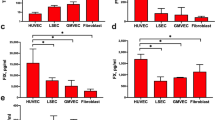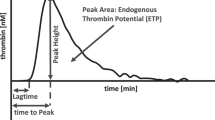Abstract
Blood coagulation in vivo is initiated by factor VII (FVII) binding to its cellular receptor tissue factor (TF)1,2,3,4. FVII is the only known ligand for TF, so it was expected that FVII-deficient embryos would have a similar phenotype to TF-deficient embryos, which have defective vitello-embryonic circulation and die around 9.5 days of gestation5,6,7,8. Surprisingly, we find that FVII-deficient (FVII−/−) embryos developed normally. FVII−/− mice succumbed perinatally because of fatal haemorrhaging from normal blood vessels. At embryonic day 9.5, maternal–fetal transfer of FVII was undetectable and survival of embryos did not depend on TF–FVII-initiated fibrin formation. Thus, the TF−/− embryonic lethal and the FVII−/− survival-phenotypes suggest a role for TF during embryogenesis beyond fibrin formation.
This is a preview of subscription content, access via your institution
Access options
Subscribe to this journal
Receive 51 print issues and online access
$199.00 per year
only $3.90 per issue
Buy this article
- Purchase on Springer Link
- Instant access to full article PDF
Prices may be subject to local taxes which are calculated during checkout



Similar content being viewed by others
References
Edgington, T. S., Mackman, N., Brand, K. & Ruf, W. The structural biology of expression and function of tissue factor. Thromb. Haemost. 66, 67–79 (1991).
Nemerson, Y. Tissue Factor: then and now. Thromb. Haemost. 74, 180–284 (1995).
Petersen, L. C., Valentin, S. & Hedner, U. Regulation of the extrinsic pathway system in health and disease: the role of factor VIIa and tissue factor pathway inhibitor. Thromb. Res. 79, 1–47 (1995).
Camerer, E., Kosto, A. B. & Prydz, H. Cell biology of tissue factor, the principal initiator of blood coagulation. Thromb. Res. 81, 1–41 (1996).
Carmeliet, P. et al. Role of tissue factor in embryonic blood vessel development. Nature 383, 73–75 (1996).
Bugge, T. H. et al. Fatal embryonic bleeding events in mice lacking tissue factor, the cell-associated iniitator of blood coagulation. Proc. Natl Acad. Sci. USA 93, 6258–6263 (1996).
Toomey, J. R., Kratzer, K. E., Lasky, N. M. & Broze, G. J. J. Effect of tissue factor deficiency on mouse and tumor development. Proc. Natl Acad. Sci. USA 94, 6922–6926 (1997).
Toomey, J. R., Kratzer, K. E., Lasky, N. M., Stanton, J. J. & Broze, G. J. J Targeted disruption of the murine tissue factor gene results in embryonic lethality. Blood 88, 1583–1587 (1996).
Bourget, P., Roulot, C. & Fernandez, H. Models for placental transfer studies of drug. Clin. Pharmacokinet. 28, 161–180 (1995).
Freeman, S. J. & Lloyd, J. B. Evidence that protein ingested by the rat visceral yolk sac yields amino acids for synthesis of embryonic protein. J. Embryol. Exp. Morph. 73, 307–315 (1983).
Freeman, S. J., Beck, F. & Lloyd, J. B. The role of the visceral yolk sac in mediating protein utilization by rat embryos cultured in vitro. J. Embryol. Exp. Morph. 66, 223–234 (1981).
Beeby, T. L., Chasseaud, L. F., Taylor, T. & Thomsen, M. K. Distribution of the recombinant coagulation factor 125I-rFVIIa in rats. Thromb. Haemost. 70, 465–468 (1993).
Ishii, S. et al. Pharmacokinetics of human activated protein C. Drug Res. 45, 644–656 (1995).
Landor, M. Maternal-fetal transfer of immunoglobulins. Ann. Allergy Asthma Immunol. 74, 279–284 (1995).
Bromberg, M. E., Koningsberg, W. H., Madison, J. F., Pawashe, A. & Garen, A. Tissue factor promotes melanoma metastasis by a pathway independent of blood coagulation. Proc. Natl Acad. Sci. USA 92, 8205–8209 (1995).
Stanssens, P. et al. Anticoagulant repertoire of the hookworm Ancylostoma caninum. Proc. Natl Acad. Sci. USA 93, 2149–2154 (1996).
Kumada, T., Dittman, W. A. & Majerus, P. W. Arole for thrombomodulin in the pathogenesis of thrombin-induced thromboembolism in mice. Blood 71, 728–733 (1988).
Auerbach, R., Huang, H. & Lu, L. Hematopoietic stem cells in the mouse embryonic yolk sac. Stem Cells 14, 269–280 (1996).
Shivdasani, R. A. & Orkin, S. H. Erythropoiesis and globin gene expression in mice lacking the transcription factor NF-E2. Proc. Natl Acad. Sci. USA 92, 8690–8694 (1995).
Morrissey, J. H., Macik, B. G., Neuenschwander, P. F. & Comp, P. C. Quantification of activated factor VII levels in plasma using a tissue factor mutant selectively deficient in promoting FVII activation. Blood 81, 734–744 (1993).
Sato, Y., Asada, Y., Marutsuka, K., Hatakeyama, K. & Sumiyoshi, A. Tissue factor induces migration of cultured aortic smooth muscle cells. Thromb. Haemost. 75, 389–392 (1996).
Idusogie, E. et al. Characterizationof a cDNA encoding murine coagulation factor VII. Thromb. Haemost. 75, 481–487 (1996).
Simpson, E. M. et al. Genetic variation among 129 substrains and its importance for targeted mutagenesis in mice. Nature Genet. 16, 19–27 (1997).
Carmeliet, P. et al. Plasminogen activator inhibitor-1 gene-deficient mice. I. Generation by homologous recombination and characterization. J. Clin. Invest. 92, 2746–2755 (1993).
Albrecht, S. et al. Detection of circulating tissue factor and factor VII in a normal population. Thromb. Haemost. 75, 772–777 (1996).
Luther, T. et al. Tissue factor expresison during human and mouse development. Am. J. Pathol. 149, 101–113 (1996).
Carmeliet, P. et al. Amodel for arterial neointima formation using perivascular electric injury in mice. Am. J. Pathol. 150, 761–777 (1997).
Van Maele-Fabry, G., Gofflot, F. & Picard, J. J. Whole embryo culture of presomitic mouse embryos. Toxicol. in Vitro 9, 671–675 (1995).
Carmeliet, P. et al. Physiological consequences of loss of plasminogen activator gene function in mice. Nature 368, 419–424 (1994).
Acknowledgements
We thank U. Hedner and M. Ezban (Novo Nordisk, Gentofte, Denmark) for the gift of rFVIIa, P. Bergum (Corvas, San Diego, CA) for rNAPc2 measurements, J. W. Fenton (Albany, NY) for thrombin, T. Edgington and E. Conway for discussions and M. Dewerchin, V. Attenburrow, A. Bouché, I. Cornelissen, S. Danloy, F. Decock, M. Deprez, M. DeWit, E. Gils, L. Kieckens, A. Manderveld, A. Vandenhoeck, A. Van den Boomen and S. Wyns (CTG); J. Picard and N. Pacico (LDG) and H. Fehrenbach (IP) for help. These studies were supported by a grant from the National Institutes of Health and the Kleiderer/Pezold Family endowed professorship (to F.J.C.). J.C.Y.C. is a recipient of the Raymond Tower Endowed Graduate Fellowship.
Author information
Authors and Affiliations
Corresponding author
Supplementary information
Supplementary Information
Supplementary Information (PDF 4126 kb)
Rights and permissions
About this article
Cite this article
Rosen, E., Chan, J., Idusogie, E. et al. Mice lacking factor VII develop normally but suffer fatal perinatal bleeding. Nature 390, 290–294 (1997). https://doi.org/10.1038/36862
Received:
Accepted:
Issue Date:
DOI: https://doi.org/10.1038/36862
This article is cited by
-
Evaluation of the Antihemostatic and Antithrombotic Effects of Lowering Coagulation Factor VII Levels in a Non-human Primate
Cellular and Molecular Bioengineering (2020)
-
Efficient generation of FVII gene knockout mice using CRISPR/Cas9 nuclease and truncated guided RNAs
Scientific Reports (2016)
-
Genetic variants of the vitamin K dependent coagulation system and intraventricular hemorrhage in preterm infants
BMC Pediatrics (2014)
Comments
By submitting a comment you agree to abide by our Terms and Community Guidelines. If you find something abusive or that does not comply with our terms or guidelines please flag it as inappropriate.



